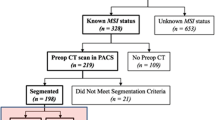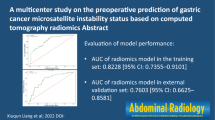Abstract
Objectives
To demonstrate the value of single-source dual-energy computed tomography (ssDECT) imaging for discriminating microsatellite instability (MSI) from microsatellite stability (MSS) colorectal cancer (CRC).
Methods
Thirty-eight and seventy-six patients with pathologically proven MSI and MSS CRC, respectively, were retrospectively selected and compared. These patients underwent contrast-enhanced abdominal ssDECT scans before any anti-cancer treatment. Effective atomic number (Eff-Z) in precontrast phase, slope k of spectral HU curve in precontrast (k-P), arterial (k-A), venous (k-V), and delayed phase (k-D), normalized iodine concentration in arterial (NIC-A), venous (NIC-V), and delayed phase (NIC-D), of tumors in two groups were measured by two reviewers. Consistency of measurements was tested by intra-class correlation coefficients (ICC). Mann-Whitney U test or Student’s t test was used to compare above values between MSI and MSS. Multivariate logistic regression was used to analyze multiple parameters. Receiver operating characteristic curves were calculated to assess diagnostic efficacies.
Results
Interobserver agreement was excellent (ICC > 0.80). MSI CRC had significantly lower values in all measurements (NIC-A, V, D; k-P, A, V, D; Eff-Z) than MSS CRC. For discriminating MSI from MSS CRC, the area under curve (AUC) using k-A was the highest (AUC, 0.803; sensitivity, 72.4%; specificity, 76.3%). The multivariate logistic regression (selection method, Enter) with combined ssDECT parameters (NIC-A, NIC-V, NIC-D, Eff-Z, k-P, k-A, k-V, k-D) significantly improved diagnostic capability with AUC of 0.886 (sensitivity, 81.6%; specificity, 81.6%).
Conclusions
The combination of multiple parameters in ssDECT imaging by multivariate logistic regression provides relatively high diagnostic accuracy for discriminating MSI from MSS CRC.
Key Points
• ssDECT generates multiple parameters for discriminating CRC with MSI from MSS.
• ssDECT measurements for MSI CRC were significantly lower than MSS CRC.
• Combination of ssDECT parameters further improves diagnostic capability for differentiation.





Similar content being viewed by others
Abbreviations
- AUC:
-
Area under the curve
- CRC:
-
Colorectal cancer
- DNA:
-
Deoxyribonucleic acid
- Eff-Z:
-
Effective atomic number
- GSI:
-
Gemstone Spectral Imaging
- IC:
-
Iodine concentration
- ICC:
-
Intra-class correlation coefficients
- IHC:
-
Immunohistochemistry
- MMR:
-
Mismatch repair
- MRI:
-
Magnetic resonance imaging
- MSI:
-
Microsatellite instability
- MSS:
-
Microsatellite stability
- NIC:
-
Normalized iodine concentration
- PCR:
-
Polymerase chain reaction
- PET-CT:
-
Positron emission tomography/computed tomography
- ROI:
-
Region of interest
- ssDECT:
-
Single-source dual-energy computed tomography
References
Siegel RL, Miller KD, Fedewa SA et al (2017) Colorectal cancer statistics, 2017. CA Cancer J Clin 67:104–117
Sinicrope FA (2018) Evaluation of the combined variable of MSI and BRAF with prognosis in colorectal cancer. Clin Gastroenterol Hepatol. https://doi.org/10.1016/j.cgh.2018.06.038
Gelsomino F, Barbolini M, Spallanzani A, Pugliese G, Cascinu S (2016) The evolving role of microsatellite instability in colorectal cancer: a review. Cancer Treat Rev 51:19–26
Benson AB 3rd, Venook AP, Cederquist L et al (2017) Colon cancer, version 1.2017, NCCN clinical practice guidelines in oncology. J Natl Compr Canc Netw 15:370–398
Passardi A, Canale M, Valgiusti M, Ulivi P (2017) Immune checkpoints as a target for colorectal cancer treatment. Int J Mol Sci 18(6):1324
Ryan E, Sheahan K, Creavin B, Mohan HM, Winter DC (2017) The current value of determining the mismatch repair status of colorectal cancer: a rationale for routine testing. Crit Rev Oncol Hematol 116:38–57
Árnadóttir S, Jeppesen M, Lamy P et al (2018) Characterization of genetic intratumor heterogeneity in colorectal cancer and matching patient-derived spheroid cultures. Mol Oncol 12:132–147
Marin D, Boll D, Mileto A, Nelson R (2014) State of the art: dual-energy CT of the abdomen. Radiology 271:327–342
Alnajami I, Drue HC, Steele R, Baatrup G (2017) Dual energy CT - a possible new method to assess regression of rectal cancers after neoadjuvant treatment. J Surg Oncol 116(8):984–988
Gong H, Zhang K, Wu L et al (2016) Dual energy spectral CT imaging for colorectal cancer grading: a preliminary study. PLoS One 11:e0147756
Fan S, Li X, Zheng L, Hu D, Ren X, Ye Z (2017) Correlations between the iodine concentrations from dual energy computed tomography and molecular markers Ki-67 and HIF-1α in rectal cancer: a preliminary study. Eur J Radiol 96:109
Kang HJ, Kim SH, Bae JS, Sun KJ, Han JK (2018) Can quantitative iodine parameters on DECT replace perfusion CT parameters in colorectal cancers? Eur Radiol 28(11):4775–4782
Hollingsworth SJ, Drye ER, Tou SI, Boulos PB (2005) Expression of angiogenic VEGF-A (soluble isoforms 121, 165) and lymphangiogenic VEGF-C in colorectal cancers with micro-satellite instability. J Surg Oncol 92(4):317–325
De Smedt L, Lemahieu J, Palmans S et al (2015) Microsatellite instable vs stable colon carcinomas: analysis of tumour heterogeneity, inflammation and angiogenesis. Br J Cancer 113(3):500–509
Toh J, Chapuis P, Bokey L, Chan C, Spring K, Dent OF (2017) Competing risks analysis of microsatellite instability as a prognostic factor in colorectal cancer. Br J Surg 104:1250–1259
Rigau V, Sebbagh N, Olschwang S et al (2003) Microsatellite instability in colorectal carcinoma. The comparison of immunohistochemistry and molecular biology suggests a role for hMSH6 [correction of hMLH6] immunostaining. Arch Pathol Lab Med 127:694–700
Cui Y, Gao S, Wang Z et al (2012) Which should be the routine cross-sectional reconstruction mode in spectral CT imaging: monochromatic or polychromatic? Br J Radiol 85:e887–e890
Li M, Zhang L, Tang W, Jin YJ, Qi LL, Wu N (2018) Identification of epidermal growth factor receptor mutations in pulmonary adenocarcinoma using dual-energy spectral computed tomography. Eur Radiol 2018:1–9
Mileto A, Allen BC, Pietryga JA et al (2017) Characterization of incidental renal mass with dual-energy CT: diagnostic accuracy of effective atomic number maps for discriminating nonenhancing cysts from enhancing masses. AJR Am J Roentgenol 209(4):W221–W230
Sinicrope FA, Rego RL, Garrity-Park MM et al (2007) Alterations in cell proliferation and apoptosis in colon cancers with microsatellite instability. Int J Cancer 2007:1232–1238
Bernal M, Concha A, Sáenz-López P et al (2011) Leukocyte infiltrate in gastrointestinal adenocarcinomas is strongly associated with tumor microsatellite instability but not with tumor immunogenicity. Cancer Immunol Immunother 60(6):869–882
Lee SY, Miyai K, Han HS et al (2012) Microsatellite instability, EMAST, and morphology associations with T cell infiltration in colorectal neoplasia. Dig Dis Sci 57(1):72–78
Maby P, Tougeron D, Hamieh M et al (2015) Correlation between density of CD8+ T-cell infiltrate in microsatellite unstable colorectal cancers and frameshift mutations: a rationale for personalized immunotherapy. Cancer Res 75(17):3446–3455
Apfaltrer P, Meyer M, Meier C et al (2012) Contrast-enhanced dual-energy CT of gastrointestinal stromal tumors: is iodine-related attenuation a potential indicator of tumor response? Invest Radiol 47:65–70
Mirus M, Tokalov SV, Wolf G, Heinold J, Prochnow V, Abolmaali N (2017) Noninvasive assessment and quantification of tumour vascularisation using MRI and CT in a tumour model with modifiable angiogenesis - an animal experimental prospective cohort study. Eur Radiol Exp 1:15
Wynter CV, Simms LA, Buttenshaw RL et al (2015) Angiogenic factor VEGF is decreased in human colorectal neoplasms showing DNA microsatellite instability. J Pathol 189(3):319–325
Miyamoto N, Yamamoto H, Taniguchi H et al (2007) Differential expression of angiogenesis-related genes in human gastric cancers with and those without high-frequency microsatellite instability. Cancer Lett 254(1):42–53
Ajmi EA, Forghani B, Reinhold C, Bayat M, Forghani R (2018) Spectral multi-energy CT texture analysis with machine learning for tissue classification: an investigation using classification of benign parotid tumours as a testing paradigm. Eur Radiol 28(6):2604–2611
Bhosale P, Ramalingam P, Ma J et al (2017) Can reduced field-of-view diffusion sequence help assess microsatellite instability in FIGO stage 1 endometrial cancer? J Magn Reson Imaging 45:1216–1224
Hong H, Kim S, Park H et al (2013) Correlations of dynamic contrast-enhanced magnetic resonance imaging with morphologic, angiogenic, and molecular prognostic factors in rectal cancer. Yonsei Med J 54:123–130
Chung H, Lee S, Han H et al (2013) Gastric cancers with microsatellite instability exhibit high fluorodeoxyglucose uptake on positron emission tomography. Gastric Cancer 16:185–192
Funding
This work was supported by the Program for Training Capital Science and Technology Leading Talents (No. Z181100006318003).
Author information
Authors and Affiliations
Corresponding author
Ethics declarations
Guarantor
The scientific guarantor of this publication is Ailian Liu.
Conflict of interest
The authors of this manuscript declare no relationships with any companies whose products or services may be related to the subject matter of the article.
Statistics and biometry
No complex statistical methods were necessary for this paper.
Informed consent
The informed consent was waived by the Institutional Review Board due to its retrospective design.
Ethical approval
This retrospective study was approved by the Institutional Ethics Committee of the First Affiliated Hospital of Dalian Medical University (Dalian, China) and was performed in accordance with the ethical guidelines of the Declaration of Helsinki.
Methodology
• Retrospective
• Observational
• Performed at one institution
Additional information
Publisher’s note
Springer Nature remains neutral with regard to jurisdictional claims in published maps and institutional affiliations.
Electronic supplementary material
ESM 1
(DOC 34 kb)
Rights and permissions
About this article
Cite this article
Wu, J., Lv, Y., Wang, N. et al. The value of single-source dual-energy CT imaging for discriminating microsatellite instability from microsatellite stability human colorectal cancer. Eur Radiol 29, 3782–3790 (2019). https://doi.org/10.1007/s00330-019-06144-5
Received:
Revised:
Accepted:
Published:
Issue Date:
DOI: https://doi.org/10.1007/s00330-019-06144-5




